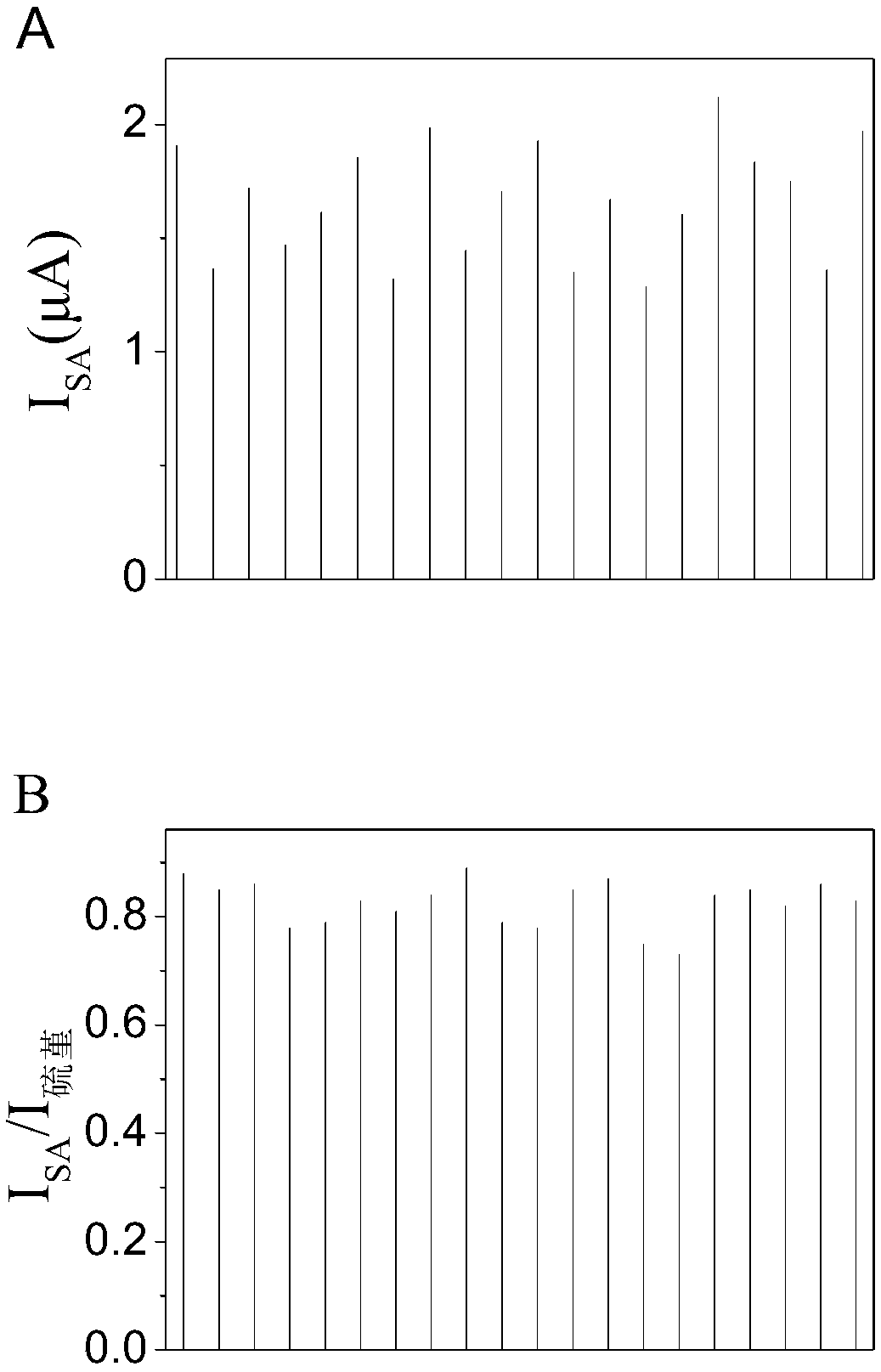Micro rate type sensor for bio-assay of salicylic acid as well as construction method and application thereof
A technology of salicylic acid and microfilament, which is applied in the direction of instruments, measuring devices, scientific instruments, etc., can solve the problems of complex biological samples, restrictions on practical application, and poor reproducibility, so as to improve stability and reproducibility, and realize accurate Effects on sex and reliability
- Summary
- Abstract
- Description
- Claims
- Application Information
AI Technical Summary
Problems solved by technology
Method used
Image
Examples
Embodiment 1
[0045] Example 1 Constructing a Miniature Ratio Sensor
[0046] (1) Connect a platinum microwire with a diameter of 100 μm to a copper wire, seal it in a glass tube, then seal the glass tube with insulating glue and epoxy resin, and expose a part of the copper wire as a wire at one end, and expose about 2mm platinum microwire at the other end Make electrodes.
[0047] Boil the platinum microwires in concentrated nitric acid for about 3-10 minutes, then ultrasonically wash them in acetone and double distilled water respectively; 0.7V cyclic voltammetry scan until the ideal cyclic voltammetry is obtained;
[0048](2) GO and acidified MWNT were dissolved in 1 mL ultrapure water at a mass ratio of 1:2, and then 2 mg of thionine was added to the above 1 mL GO / MWNT mixed solution, and sonicated for 4 h. Preparation of nanoclusters of thionine / GO / MWNT. Purify by centrifugation and wash with ultrapure water several times until it is washed, and resuspend the precipitate in 1 mL of ...
experiment example 1
[0053] Collect 4 ratiometric sensors constructed in Example 1 and non-ratiosensors constructed in Comparative Example 1 to compare the 20 detection results of the same concentration of SA. For the statistical results, see figure 2 . The relative standard deviation (RSD) of the non-ratio sensor is 15.4%, while the RSD of the ratio sensor is 5.2%, and the reproducibility is significantly higher than that of the non-ratio sensor. figure 2 Among them, A represents a non-ratio sensor, and B represents a ratio sensor.
experiment example 2
[0054] Experimental example 2 On-line detection of plant salicylic acid in vivo
[0055] The platinum wire microelectrode sensor modified in Example 1 was used to detect SA in sunflower seedlings treated with salt stress in vivo.
[0056] 1) use the microelectrode modified in embodiment 1 as working electrode, Ag / AgCl wire as reference electrode, platinum wire as counter electrode, test SA standard solution by cyclic voltammetry, ratiometric sensor uses the oxidation current of SA and thionine The ratio of the oxidation current corresponds to the concentration of SA to establish a standard curve.
[0057] For the non-ratiometric sensor constructed in Comparative Example 1, a standard curve was established with the oxidation current of SA corresponding to the concentration of SA.
[0058] 2) Taking sunflower seedlings as the test object, set up the control group (0mm NaCl), the treatment group 1 (50mm NaCl) and the treatment group 2 (100mm NaCl).
[0059] The sunflower seedli...
PUM
| Property | Measurement | Unit |
|---|---|---|
| Diameter | aaaaa | aaaaa |
| Diameter | aaaaa | aaaaa |
| Concentration | aaaaa | aaaaa |
Abstract
Description
Claims
Application Information
 Login to View More
Login to View More - R&D
- Intellectual Property
- Life Sciences
- Materials
- Tech Scout
- Unparalleled Data Quality
- Higher Quality Content
- 60% Fewer Hallucinations
Browse by: Latest US Patents, China's latest patents, Technical Efficacy Thesaurus, Application Domain, Technology Topic, Popular Technical Reports.
© 2025 PatSnap. All rights reserved.Legal|Privacy policy|Modern Slavery Act Transparency Statement|Sitemap|About US| Contact US: help@patsnap.com


